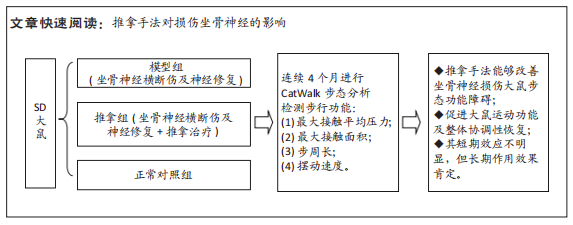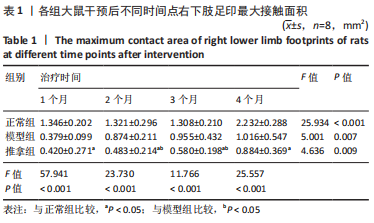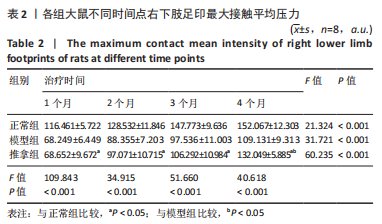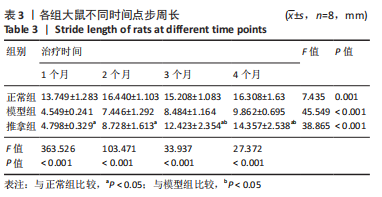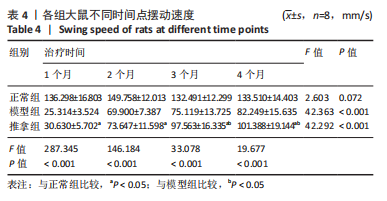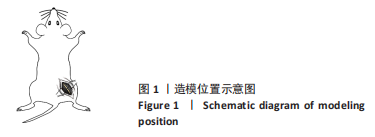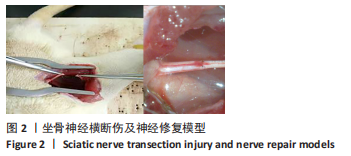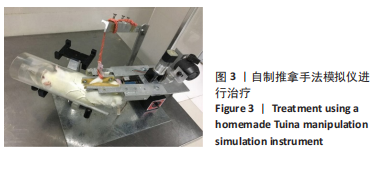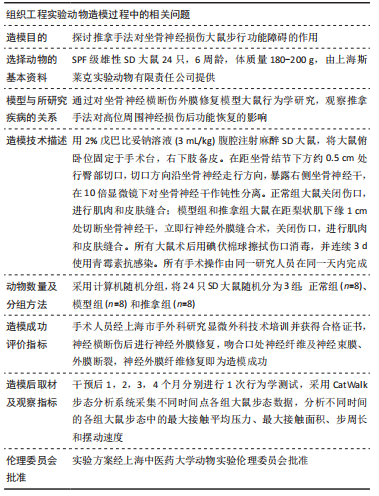[1] LI R, LIU Z, PAN Y, et al. Peripheral nerve injuries treatment: a systematic review. Cell Biochem Biophys. 2014;68(3):449-454.
[2] DEUMENS R, BOZKURT A, MEEK MF, et al. Repairing injured peripheral nerves: Bridging the gap. Prog Neurobiol. 2010;92(3):245-276.
[3] 任玉衡,田得祥.优秀运动员的运动创伤流行病学调查[J].中国运动医学杂志,2000,19(4):377-386.
[4] MUMMOLO C, MANGIALARDI L, KIM JH. Quantifying dynamic characteristics of human walking for comprehensive gait cycle. J Biomech Eng. 2013;135(9):91006.
[5] 康思凡.不同手机使用任务对大学生行走步态影响的研究[D].西安:陕西师范大学,2021.
[6] ZHANG Y, XU X, TONG Y, et al. Therapeutic effects of peripherally administrated neural crest stem cells on pain and spinal cord changes after sciatic nerve transection. Stem Cell Res Ther. 2021;12(1):180.
[7] 刘欣昊,马书杰,丁道芳,等. 基于DigiGait成像系统的帕金森病模型大鼠行为学分析[J].康复学报,2022,32(4):320-325.
[8] GABRIEL AF, MARCUS MA, HONIG WM, et al. The CatWalk method: a detailed analysis of behavioral changes after acute inflammatory pain in the rat. J Neurosci Methods. 2007;163(1):9-16.
[9] ISVORANU G, MANOLE E, NEAGU M. Gait Analysis Using Animal Models of Peripheral Nerve and Spinal Cord Injuries. Biomedicines. 2021;9(8):1050.
[10] KNORR S, RAUSCHENBERGER L, LANG T, et al. Multifactorial Assessment of Motor Behavior in Rats after Unilateral Sciatic Nerve Crush Injury. J Vis Exp. 2021;(173). doi: 10.3791/62606.
[11] HEINZEL J, LÄNGLE G, OBERHAUSER V, et al. Use of the CatWalk gait analysis system to assess functional recovery in rodent models of peripheral nerve injury - a systematic review. J Neurosci Methods. 2020;345:108889.
[12] DEUMENS R, JAKEN RJ, MARCUS MA, et al. The CatWalk gait analysis in assessment of both dynamic and static gait changes after adult rat sciatic nerve resection. J Neurosci Methods. 2007;164(1):120-130.
[13] WU JJ, LU YC, HUA XY, et al. A Longitudinal Mapping Study on Cortical Plasticity of Peripheral Nerve Injury Treated by Direct Anastomosis and Electroacupuncture in Rats. World Neurosurg. 2018;114:e267-e282.
[14] WU JJ, LU YC, HUA XY, et al. Cortical remodeling after electroacupuncture therapy in peripheral nerve repairing model. Brain Res. 2018;1690:61-73.
[15] VOGELAAR CF, VRINTEN DH, HOEKMAN MF, et al. Sciatic nerve regeneration in mice and rats: recovery of sensory innervation is followed by a slowly retreating neuropathic pain-like syndrome. Brain Res. 2004;1027(1-2):67-72.
[16] 万军,郭鑫.推拿治疗周围神经损伤研究进展[J].辽宁中医药大学学报,2021,23(2): 214-220.
[17] YIN L, AN Y, CHEN X, et al. Local vibration therapy promotes the recovery of nerve function in rats with sciatic nerve injury. J Integr Med. 2022;20(3):265-273.
[18] LV T, MO Y, YU T, et al. An Investigation into the Rehabilitative Mechanism of Tuina in the Treatment of Sciatic Nerve Injury. Evid Based Complement Alternat Med. 2020;2020:5859298.
[19] LV TT, MO YJ, YU TY, et al. Using RNA-Seq to Explore the Repair Mechanism of the Three Methods and Three-Acupoint Technique on DRGs in Sciatic Nerve Injured Rats. Pain Res Manag. 2020; 2020:7531409.
[20] XING XX, ZHENG MX, HUA XY, et al. Brain plasticity after peripheral nerve injury treatment with massage therapy based on resting-state functional magnetic resonance imaging. Neural Regen Res. 2021;16(2): 388-393.
[21] 马翔,唐成林,赵丹丹,等.推拿对失神经肌萎缩大鼠肌特异性microRNA和肌卫星细胞增殖分化相关因子的影响[J].中国康复理论与实践,2020,26(11):1297-1304.
[22] 安荟羽,唐成林,黄思琴,等.推拿对失神经骨骼肌萎缩大鼠自噬相关因子Beclin-1、液泡分选蛋白34和微管相关蛋白轻链3的mRNA表达的影响[J].中国康复理论与实践,2019,25(2):184-191.
[23] 卢裕强,郭汝宝.推拿手法对家兔骨骼肌失神经支配后成肌调节因子Myf-5、Myogenin表达的影响[J].浙江中西医结合杂志,2019, 29(12):979-984.
[24] 罗宇婷,莫岩君,吕桃桃,等.“三法三穴”对坐骨神经损伤大鼠背根神经节中cAMP及PKA表达的影响[J].环球中医药,2020,13(4): 555-560.
[25] 李易真,杨超,于天源,等.“三法三穴”推拿手法对坐骨神经损伤大鼠运动功能和脊髓NogoA及其受体表达的影响[J].中国康复理论与实践,2018,24(12):1403-1407.
[26] 沈熠,莫岩君,于天源,等.“三法三穴”推拿手法对大鼠坐骨神经损伤后髓鞘厚度和神经调节蛋白1-人类表皮生长因子受体2表达的影响[J].中国康复理论与实践,2020,26(4):423-431.
[27] 吕桃桃,杨超,于天源,等.三法三穴对坐骨神经损伤大鼠下行性通路超微结构的影响[J].中华中医药杂志,2019,34(11):5112-5116.
[28] 吕桃桃,邵帅,于天源,等.基于RNA测序技术分析推拿对大鼠坐骨神经损伤点的基因表达影响[J].中华中医药杂志,2020,35(5): 2589-2592.
[29] BOLÍVAR S, NAVARRO X, UDINA E. Schwann Cell Role in Selectivity of Nerve Regeneration. Cells. 2020;9(9):2131.
[30] WOOD KL, FONSECA MIA, GUNDERSON KA, et al. Local Environment Induces Differential Gene Expression in Regenerating Nerves. J Surg Res. 2022;278:418-432.
[31] WANG Z, YI XZ, YU AX. Regenerative peripheral nerve interface prevents neuroma formation after peripheral nerve transection. Neural Regen Res. 2023;18(4):814-818.
[32] MILEK D, ECHTERNACHT SR, LAGUARDIA J, et al. Evaluation of peripheral nerve regeneration in Murphy Roths Large mouse strain following transection injury. Regen Med. 2022. doi: 10.2217/rme-2022-0098. Online ahead of print.
[33] GANASSI M, ZAMMIT PS. Involvement of muscle satellite cell dysfunction in neuromuscular disorders: Expanding the portfolio of satellite cell-opathies. Eur J Transl Myol. 2022;32(1):10064. |
